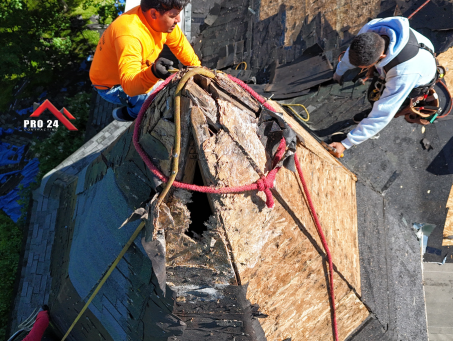Roof restoration is an excellent way to breathe new life into your roof without the expense of a full replacement. This process focuses on repairing, cleaning, and enhancing the protective qualities of your roof, extending its lifespan and boosting your home’s curb appeal. If you’re considering this option, you might wonder, “What does the roof restoration process entail?” This guide will break down every step so you’ll know exactly what to expect.
Why Choose Roof Restoration?
Before diving into the steps, let’s explore why homeowners opt for roof restoration over replacement:
- Cost-Effectiveness. Restoring a roof is often more affordable than replacing it entirely.
- Improved Durability. Restoration adds protective coatings and repairs minor issues before they escalate.
- Eco-Friendly. Extending the life of your existing roof reduces waste and conserves resources.
- Enhanced Appearance. Cleaning and recoating can make an old roof look brand-new.
Step 1: Initial Inspection and Assessment
The roof restoration process begins with a thorough inspection. Roofing professionals will evaluate the condition of your roof to determine if restoration is viable or if replacement might be necessary.
Key aspects of the assessment include:
- Identifying Damage. Checking for cracked tiles, rust, leaks, and structural issues.
- Measuring Wear. Assessing the age and overall wear of the roof materials.
- Analyzing Problem Areas. Pinpointing areas prone to water pooling, mold, or moss growth.
After the inspection, you’ll receive a detailed report outlining the recommended steps and costs associated with the restoration.
Step 2: Preparing the Roof for Restoration
Preparation is critical to ensure the success of the restoration process. Here’s what happens during this phase:
- Roof Cleaning. Pressure washing removes dirt, debris, moss, algae, and lichen from the surface. A clean roof ensures the repair materials and coatings adhere properly.
- Clearing Gutters. Debris in gutters can hinder water flow, so they’re cleaned thoroughly to prevent future issues.
- Temporary Fixes. Any immediate problems, like loose shingles or leaks, may be temporarily addressed to prevent damage during cleaning.
This step ensures the roof is a blank slate, ready for the restoration work ahead.
Step 3: Repairing Damage
Once the roof is cleaned, contractors focus on repairing any damage found during the initial inspection. This stage varies depending on the roof type and extent of the issues.
Common repairs include:
- Replacing Damaged Shingles or Tiles. Cracked or missing tiles are swapped out to restore the roof’s integrity.
- Fixing Leaks. Sealing gaps and replacing damaged flashing to prevent water intrusion.
- Reinforcing Weak Spots. Strengthening areas that show signs of wear to avoid future problems.
For metal roofs, this stage might involve treating rust and resecuring loose panels. For tiled roofs, resealing or rebedding tiles is often required.
Step 4: Applying Protective Coatings
The most transformative part of the roof restoration process is applying protective coatings. These coatings are essential for improving the roof’s durability, energy efficiency, and appearance.
- Primer. A primer coat is often applied to enhance the adhesion of the topcoat and ensure an even finish.
- Sealants. Roof sealants are used to waterproof the surface, protecting it from leaks and weather damage.
- Reflective Coatings. In many cases, reflective or heat-resistant coatings are added to reduce energy costs by improving insulation.
- Topcoat. The final layer enhances the roof’s aesthetic appeal while offering UV protection and resistance to wear.
These coatings are specially designed for the type of roof material being restored, ensuring long-lasting results.
Step 5: Final Inspection and Quality Assurance
After the restoration work is complete, the roofing team will conduct a final inspection to ensure everything meets professional standards. This includes:
- Checking the integrity of repairs and coatings.
- Verifying that all leaks, cracks, or weak spots are addressed.
- Ensuring the gutters and drainage systems are functioning properly.
This stage ensures that the roof restoration was executed to the highest standards, leaving you with a roof that looks and performs like new.
How Long Does the Roof Restoration Process Take?
The time required for roof restoration depends on the size and complexity of your roof and the extent of the repairs needed. On average…
- Cleaning and preparation take 1–2 days.
- Repairs take 1–3 days.
- Coating application takes 2–3 days (with drying time between layers).
In most cases, the entire process is completed within a week.
What to Expect During the Process
As a homeowner, it’s natural to wonder how the roof restoration process will impact your daily routine. Understanding what to expect can help you prepare and make the experience smoother. Here are some key aspects to consider:
i. Noise
Roofing work is inherently noisy. From the sound of hammering nails to the hum of power tools, you can expect a fair amount of commotion during the restoration process. If you work from home, have small children, or are sensitive to noise, you might want to plan accordingly.
Consider setting up a temporary workspace away from the construction area or using noise-canceling headphones to minimize the disruption.
For those with pets, it’s a good idea to provide a safe, quiet space where they can retreat from unfamiliar sounds.
ii. Access
Your roofing team will need unobstructed access to your yard, driveway, and sometimes parts of your home’s exterior. Ladders, scaffolding, and other equipment may be placed in these areas to ensure the crew can work efficiently and safely.
If you typically park in your driveway, you may need to relocate your vehicle temporarily to allow space for material deliveries and equipment staging. Clear pathways and remove outdoor furniture, planters, or other items that could impede the crew’s access.
iii. Safety
Reputable roofing contractors prioritize safety—for their team, your home, and your family. They’ll follow strict safety protocols, including securing ladders, using protective gear, and safeguarding the work area to minimize risks.
While the crew will take measures to protect your property, you can help by keeping children and pets away from the work zone to avoid accidental injuries. Contractors will also clean up debris, nails, and other materials regularly to ensure your yard remains safe during the project.
iv. Communication
One of the most important aspects of the restoration process is open and ongoing communication. Your roofing team will keep you informed at every stage of the project, from the initial inspection to the final cleanup.
They’ll let you know what to expect each day, address any questions or concerns you may have, and provide updates on the project timeline. If unexpected issues arise, such as hidden damage or weather delays, they’ll consult with you promptly to adjust plans as needed.
By understanding these aspects of the roofing restoration process, you can better prepare for temporary adjustments to your routine. Rest assured that professional roofing teams work with efficiency and care to complete the project as quickly and smoothly as possible, minimizing disruptions to your daily life.
Common Misconceptions About Roof Restoration
- “Restoration is just a cosmetic fix.”
Roof restoration goes beyond aesthetics. It strengthens your roof, protects against damage, and extends its lifespan. - “It’s only for old roofs.”
While older roofs benefit the most, even newer roofs can undergo restoration to prevent early wear and tear. - “All roofs can be restored.”
Severely damaged or structurally unsound roofs may require replacement instead of restoration.
Benefits of Roof Restoration
Still don’t have enough reasons to restore your roof? Here are more benefits:
- Extended Lifespan. Roof restoration adds 10 to 15 years to your roof’s durability.
- Increased Property Value. A well-maintained roof improves curb appeal and boosts resale value.
- Lower Energy Bills. Reflective coatings can reduce heat absorption, lowering cooling costs.
- Eco-Friendly Solution. Finally, opting for a roof restoration produces less waste compared to a roof replacement.
By investing in roof restoration, homeowners can enjoy these advantages without the hefty price tag of a new roof.
How to Choose a Roof Restoration Company
Not all roofing contractors are created equal. Here’s how to find the right team for your project:
- Experience. Look for companies with a proven track record in roof restoration.
- Certifications. Ensure the contractor is licensed, insured, and certified.
- Reviews. Check online reviews and testimonials to gauge customer satisfaction.
- Transparency. Choose a company that provides a detailed estimate and explains the process thoroughly.
At Pro 24 Contracting, we specialize in delivering high-quality roof restoration services. Our experienced team is dedicated to helping homeowners protect their investments and enhance their home’s appearance.
To Sum up
The roof restoration process is a complete and transformative solution designed to repair, protect, and rejuvenate your roof, ensuring it delivers peak performance for years to come. This multi-step approach goes beyond addressing visible wear and tear—it revitalizes the entire roofing system, enhancing durability, energy efficiency, and curb appeal. Whether your roof has sustained minor damage, weathered years of exposure, or simply needs a fresh look, roof restoration provides a cost-effective alternative to full replacement.
The process typically begins with a thorough inspection to identify problem areas, such as cracks, leaks, or damaged materials. Once the issues are pinpointed, the restoration team gets to work. The roof is cleaned to remove dirt, moss, algae, and other debris that can compromise its integrity. Next, repairs are made to fix any damaged shingles, flashing, or structural components. This attention to detail ensures that the roof is sound before protective measures are applied.
Investing in roof restoration offers homeowners a wide range of benefits. In addition to extending the lifespan of your roof, restoration enhances its aesthetic appeal, boosting your home’s overall value and appearance. It’s a sustainable choice as well, reducing the waste and expense associated with roof replacements. Furthermore, by addressing minor issues before they escalate into costly repairs, roof restoration helps save money over the long term.
Ready to breathe new life into your roof? Contact Pro 24 today. Our experienced team will guide you through the restoration process, ensuring your roof is stronger, more efficient, and more beautiful than ever. Don’t wait—let us help you protect your home and elevate its value with a professionally restored roof!

